
Original Link: https://www.anandtech.com/show/2278
PC Power & Cooling Silencer 750 Quad CF-Edition
by Christoph Katzer on July 18, 2007 1:00 AM EST- Posted in
- Cases/Cooling/PSUs
Introduction
PC Power & Cooling has been in the US-market for a long time, but for people in Europe it is a new name. Since the recent acquisition of PCP&C by OCZ Technology Group their channels have been extended into the European market, et voila they are available throughout Europe a week later. Since OCZ will keep the name PC Power & Cooling (PCP&C) we will continue to use their current name. OCZ will make no changes in the power supply lineup of PCP&C and therefore the power supplies from today are the same as those from half a year ago.
Today we will have a look at the Silencer 750 Quad in the Crossfire-Edition which comes in a bright red color. It is advertised as the godfather of silence and comes rated at 750W, which is more than most PCs need. Because a 750w power supply will become very hot if fully loaded, we have to express doubt that it is possible to keep it cool while remaining "silent" - especially if there is only a single 80mm fan installed like in this PSU.

The voltage input can handle everything from 100 to 240V, so the power supply can work in any region of the world. The label tells us that this unit comes with a single 12V rail. PCP&C was one of the first companies to introduce this new method, while many others continue with designs that include four separate 12V rails rated at only 20 amps each. The 750 Quad delivers up to 60 amps on the 12V rail which then supports all of the various system components.
A single 12V rail doesn't come without issues though. At first you might think you will never encounter problems with OCP (Over Current Protection) kicking in if you load one rail too high. This could happen if you connect one of the latest graphics cards to a 12V rail that only delivers 15 amps for example. The result is often a blue screen and/or the PC shutting down. This problem is solved with a single 12V rail that will have enough juice for everything - provided you don't need more than 60 amps, of course.

The problem with this alignment is basically the danger it brings. The latest Power Supply Design Guide states that no 12V rail should exceed more than 20 amps (240VA). If certain types of damage occur to the power supply or cables, such a high amperage could be dangerous to the end users. Electricity will always come with some risks, though, and as another manufacturer informed us the likelihood of a PSU being damaged in such a way that a 60 amp rail becomes a risk is very slim. Still, it is technically against the PSDG specifications and could be dangerous in certain instances.
Packaging and Appearance


The 750 Quad comes in a white box. The packaging and accessories are quite simple and give a clue as to the target market: enthusiasts. In the box you will find the PSU itself, a 14 AWG (American Wire Gauge) power cord, one of the shortest user manuals we have ever seen, and four mounting screws.


The power supply we're reviewing is the Crossfire-Edition that comes with a bright red paint job, perfect for anyone looking to color coordinate with an ATI Crossfire setup. Unfortunately, the red is painted on a black base and flakes off quite easily. We also noticed a particularly pungent smell from the paint that might cause headaches for some - though this smell should dissipate within a few days of the unit being unpacked.
The Fan


There is only a single fan installed in this PSU, which is somewhat surprising given the high power rating. The 80mm fan is located at the back of the housing and pulls air through the internals. The front of the unit has several long openings in it that serve as air intakes. The openings are located directly behind the components that need the most cooling, though, so the airflow is put to maximum effective use.


This is a very common arrangement as it provides for better control and direction of airflow. The fan side facing the rear is labeled with a PCP&C-sticker. Note the small decimal point in front of the 45A near the at symbol (@); for a moment we thought we had discovered the destination for most of the electricity. The other side of the fan makes the rating a bit more clear: it is an ADDA fan rated at 0.45A.


One thing we didn't mention before is the length of this power supply. At 18cm/7" in length it is a very long PSU. A look at the website of PCP&C explains the reason for the size. By keeping the fan at least one inch away from the PCB and its components, according to PCP&C this is the best way to avoid noisy air turbulence infront of the fan.
Cables and Connectors

PCP&C didn't forget anything when it comes to cables and connectors. There are enough connectors on cables of varying lengths to provide the best connectivity possible. The 4-pin drive connectors start at 35cm/14". With a length of 40cm/16" the main 24-pin ATX connector may prove a bit short for some cases but it's still acceptable - if your mainboard is mounted upside-down, though, you will likely encounter problems. All cables are sleeved until the first connector. In order to improve the appearance, the sleeves start inside the power supply. With a maximum length of 90cm/35" the cables are long enough to support even big-towers.
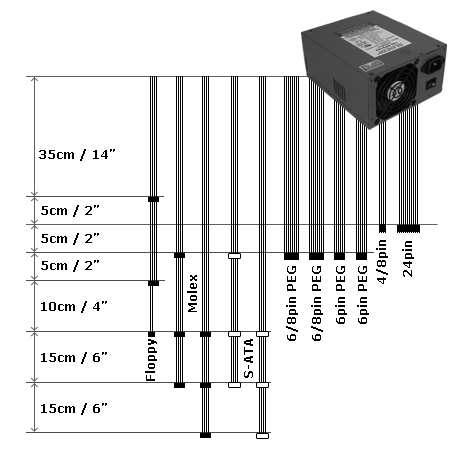
With 750W this PSU is definitely designed for multiple graphics cards. The Silencer 750 Quad is packed with four 6-pin PEG connectors, two of which can be converted into 8-pin PEG connectors. This definitely satisfies the requirements of current high-end graphics configurations, which makes sense as it pretty much requires multiple high-end GPUs to push your typical PC power requirements to anything near 750W.
Internals

After opening the cover, we are greeted with a simple, clean design. The two big heatsinks stretch across most of the interior. With their size and shape they are well designed for a power supply with an 80mm fan in the back. The air can go through the single fins to cool the interior components. A potential problem with this alignment is the components on the PCB. For example, a transformer directly in the airflow is also blocking the air and creating turbulence.

As seen above, in this particular unit the transformer and capacitor are located in between the two heatsinks. PCP&C didn't put any other important components behind them; thus they will not prevent fresh air from reaching components that need it.

Half of the filtering stage is located on a small PCB directly at the AC-inlet. Power passes through a cable into a fuse and other capacitors before it hits the rectifier bridge.

The rectifier bridge is attached to its own small heatsink which cools it down. Some of the fins have a shrinking hose attached to prevent interference with the coil sitting directly below. The coils are only connected through the two cables which makes them pretty unstable. You can see that they are being fixed by cable ties and glue - a common practice.

The active PFC is located in the end of the primary side behind a coil. The main-cap is manufactured by Nippon Chemi-Con and normally placed in this area but PCP&C had it moved beside the transformer, and there are no disadvantages in such a design.
Secondary Side


The secondary side is equipped with 105°C capacitors. For a 750W power supply the side looks quite empty. The cables, capacitors, and coils are stuck quite close together which could cause a temperature problem. With the components that close together they definitely won't get enough air for cooling purposes. The cables attached to the PCB don't have any shrinking hoses on each end which should have been done for safety reasons.



Here are a few final shots of the internals. The last shows the bottom of the PCB, which not surprisingly contains a lot of solder points.
The Testing
For our second PSU review, we have modified our test regimen slightly. We have added a low input voltage test which is currently 100VAC; in future reviews we will test as low as 90VAC, but as this power supply is rated from 100 to 240VAC we couldn't perform a 90VAC test. Not that we didn't try, but with 90VAC the power supply wouldn't start. In addition we have moved all of the rails to separate pages now. This was necessary since we now have four tests to show. Four? Yes, we have added room temperature as a category and therefore we will have an additional result. We have performed the room temperature test with 230VAC just out of convenience since we have 230VAC on our standard grid power in the lab.
Note: If you would like to know more about our testing methodology, equipment, and environment, please read our Power Supply Test Methodology overview.
3.3V Results
| 3.3V Test Results | |||
| Percentage | Ampere | Wattage | Wattage (All Rails) |
| 10% | 1.41 | 4.75 | 75.61 |
| 20% | 2.83 | 9.51 | 150.82 |
| 30% | 4.24 | 14.16 | 225.52 |
| 40% | 5.65 | 18.82 | 299.69 |
| 50% | 7.06 | 23.37 | 373.43 |
| 60% | 8.48 | 27.9 | 446.52 |
| 70% | 9.89 | 32.44 | 519.14 |
| 80% | 11.3 | 36.95 | 591.04 |
| 90% | 12.72 | 41.21 | 662.41 |
| 100% | 14.13 | 45.5 | 732.52 |
With a high ambient temperature the 3.3V rail shows a steady drop at any input voltage. The graphs are all quite similar, but the drops are within spec and we experienced no instabilities in our system. However, at a normal room temperature things look slightly different. The results are a bit closer to the optimum and don't drop as much. In any case the 3.3V rail will not cause any problems under heat influence.
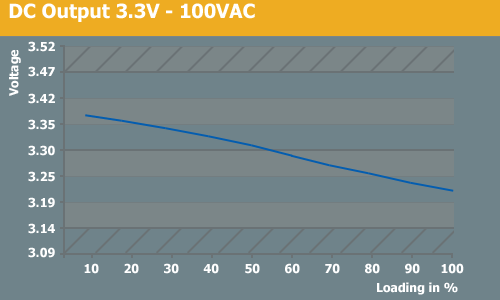
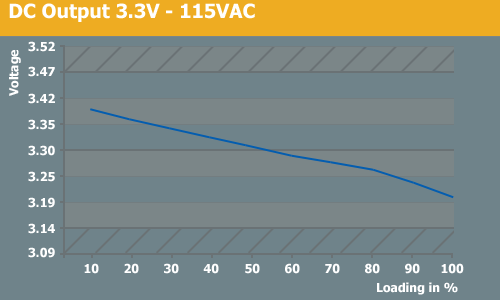
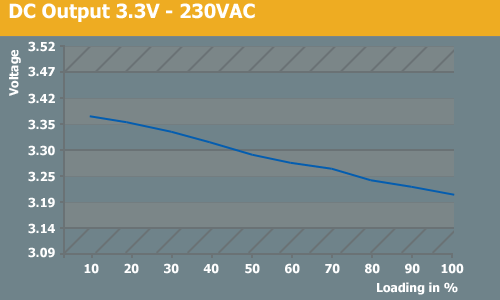
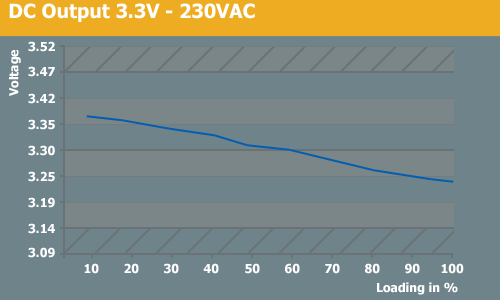
3.3V at room temperature
5V Results
| 5V Test Results | |||
| Percentage | Ampere | Wattage | Wattage (All Rails) |
| 10% | 1.77 | 8.9 | 75.61 |
| 20% | 3.53 | 17.65 | 150.82 |
| 30% | 5.3 | 26.34 | 225.52 |
| 40% | 7.06 | 34.81 | 299.69 |
| 50% | 8.83 | 43.27 | 373.43 |
| 60% | 10.6 | 51.62 | 446.52 |
| 70% | 12.36 | 59.82 | 519.14 |
| 80% | 14.13 | 67.82 | 591.04 |
| 90% | 15.89 | 75.8 | 662.41 |
| 100% | 17.66 | 83.36 | 732.52 |
With the 5V rail we again see slight problems at higher temperatures, especially at higher loads. Each load starts at a very nice, stable 5V but as the load increases the voltage drop is immediately visible. The results are all still inside spec and even at 100% load it doesn't fall out of line. It also held stable at this low voltage for an hour of full load. Even at normal room temperatures the voltage drop doesn't change much. At this point we feel PCP&C needs to work on keeping the 5V rail closer to spec, however, especially for a premium priced power supply.
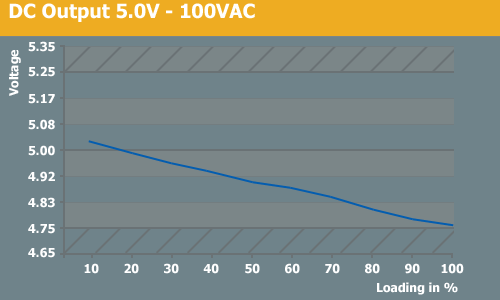
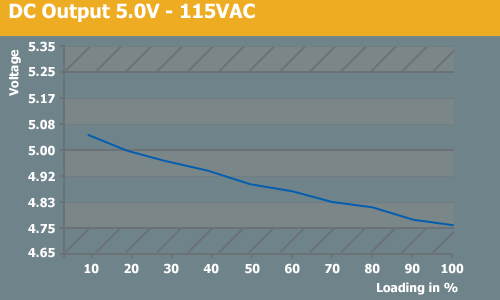
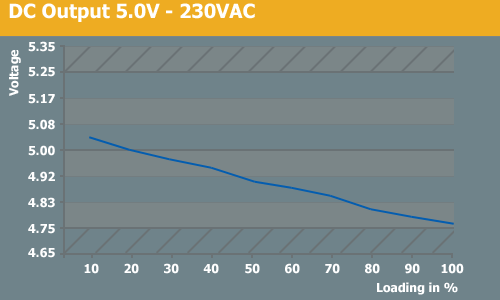
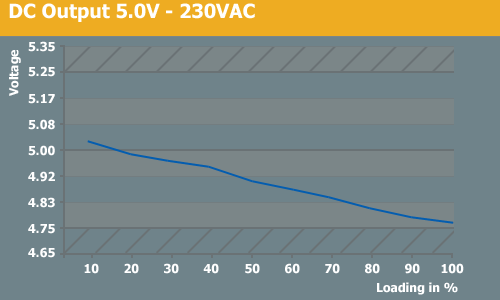
5.0V at room temperature
12V Results
| 12V Test Results | |||
| Percentage | Ampere | Wattage | Wattage (All Rails) |
| 10% | 5.03 | 60.86 | 75.61 |
| 20% | 12.05 | 121.3 | 150.82 |
| 30% | 15.08 | 181.56 | 225.52 |
| 40% | 20.11 | 241.52 | 299.69 |
| 50% | 25.13 | 301.06 | 373.43 |
| 60% | 30.16 | 360.41 | 446.52 |
| 70% | 35.19 | 419.47 | 519.14 |
| 80% | 40.21 | 477.7 | 591.04 |
| 90% | 45.24 | 535.64 | 662.41 |
| 100% | 50.26 | 592.57 | 732.52 |
To push the power supply to the limit we had to pull almost 600W out of the 12V rail which is impossible to achieve with only one cable/connector attached. The single cable would have most likely melted if we had done so. In order to avoid destroying the cables we used various kinds of connectors such as ATX, 4-pin Molex, and several 6-pin PEG connectors.
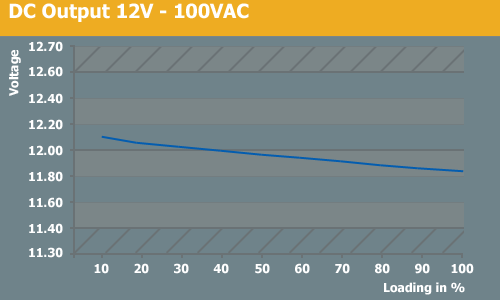
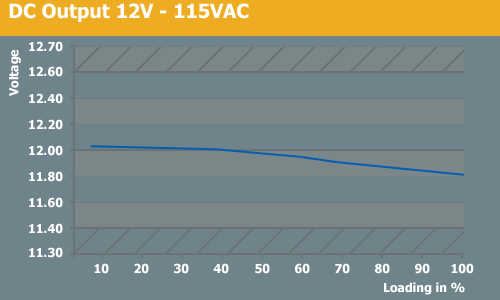
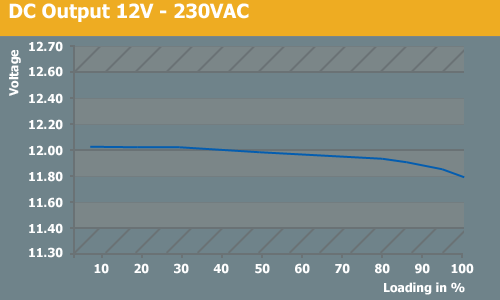
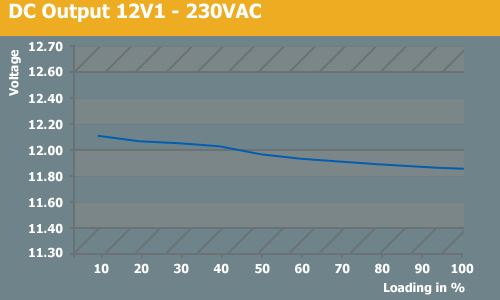
12V at room temperature
At all temperatures the 12V rail held stable over an optimal range. With increasing heat and load it went only 0.2V under 12V which will not cause any problems whatsoever. The 12V rail(s) is often the most critical aspect of a power supply, so it's good to see better results here than what we saw with the lower voltage rails.
5Vsb Results
| 5Vsb Test Results | |||
| Percentage | Ampere | Wattage | Wattage (All Rails) |
| 10% | 0.24 | 1.21 | 75.61 |
| 20% | 0.48 | 2.4 | 150.82 |
| 30% | 0.71 | 3.54 | 225.52 |
| 40% | 0.95 | 4.71 | 299.69 |
| 50% | 1.19 | 5.88 | 373.43 |
| 60% | 1.43 | 7.02 | 446.52 |
| 70% | 1.67 | 8.18 | 519.14 |
| 80% | 1.9 | 9.23 | 591.04 |
| 90% | 2.14 | 10.34 | 662.41 |
| 100% | 2.38 | 11.42 | 732.52 |
With the power supply totally shut down through the switch on the back it still used up to 0.13W from the power grid. This isn't the first time we've seen such behavior, but it is somewhat undesirable. Some power supplies still use energy even in this state, which normally should not occur since the switch is obviously turned off. With the switch on and the power cord connected the power supply uses up to 0.8W on 115VAC, which is still good since up to 2W is allowed by the Energy Star version 4.0 specifications.
If you connect the PSU to a computer it will probably use more energy since there are functions on the mainboard that will draw a bit of power in standby mode. We test the standby efficiency with loads of 0.1, 0.5, and 3 ampere. In any case it should have more than 50% efficiency.
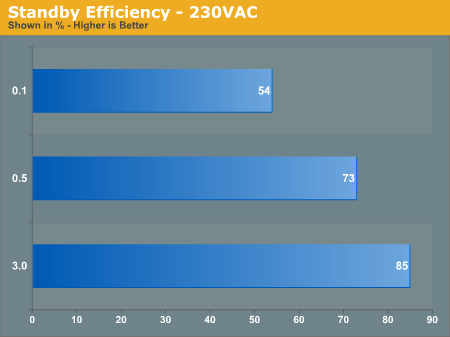
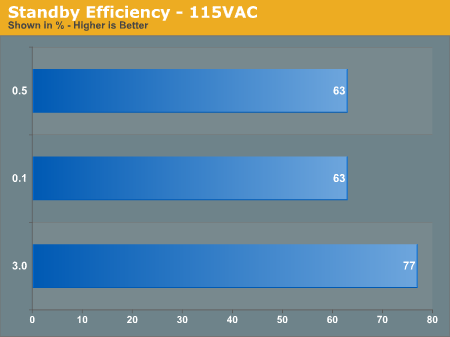
The Silencer 750 Quad had an excellent standby efficiency with up to 85%.
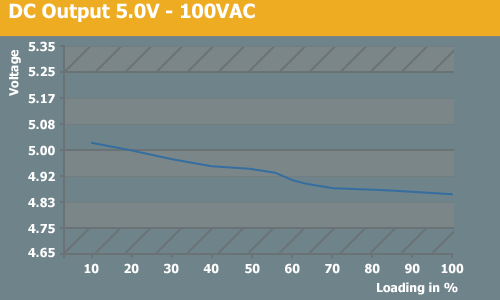
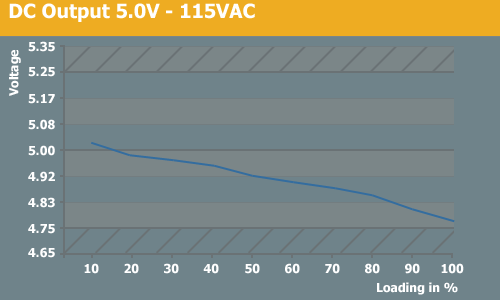
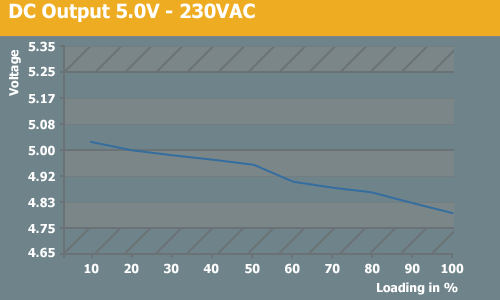
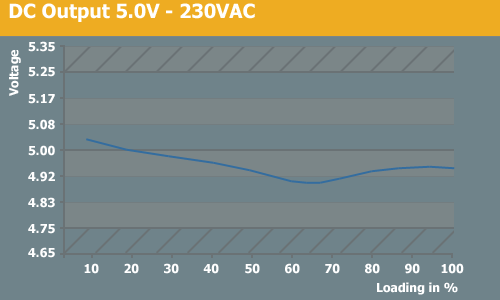
5Vsb at room temperature
Under heat influence the 5Vsb rail had problems just like the 5V rail. It went down and almost reached the bottom limit. At room temperature the result is different and we see a curve that actually begins going up again after the 60% load. This occurs because the fan begins pulling more air through since it's turning faster, and at room temperatures this helps cool the internals better than in our stress scenarios.
Efficiency
PCP&C states an efficiency of 83% on the package of this power supply, but they don't indicate what input voltage is required to reach this 83% rating. Thankfully, after testing we can say that these "up to 83% efficiency" claims are understated.
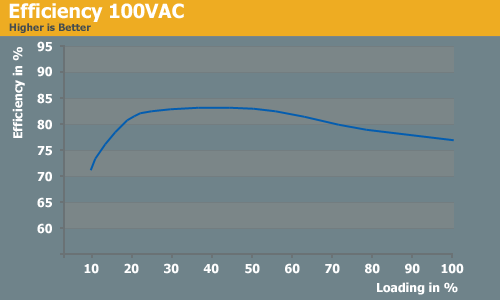
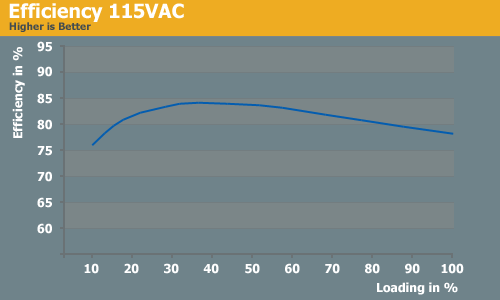
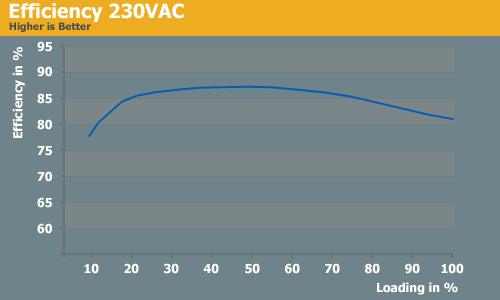
Even with an input voltage of only 100VAC we measured efficiency of up to 84%. This is the highest efficiency we have seen so far in seven years of working in this field. Two years ago Topower showed us a power supply that achieved up to 90% efficiency, but unfortunately it never made its way to market since it would have cost $200 USD for just 400W. With 230VAC the efficiency is always higher and this time we see up to 86% efficiency with only a 300W load. That's an impressive result with any of the input voltages.
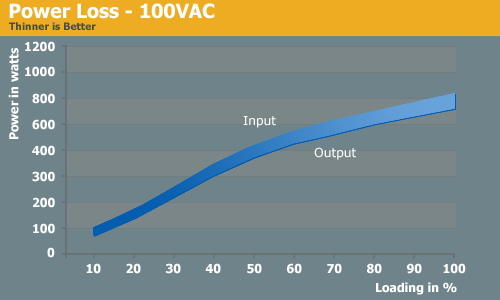
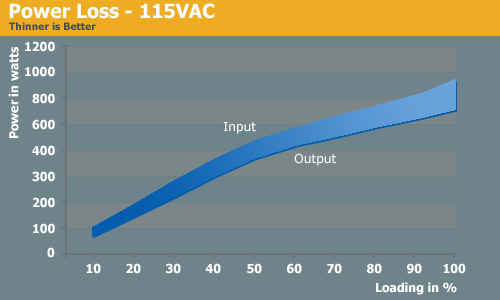
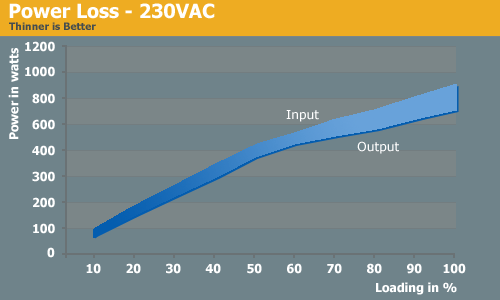
As a result of this high efficiency, the power loss is very small. The results at 230VAC are always a little bit better than at lower input voltages, as power loss is simply another way of looking at efficiency.
Power Factor Correction
As expected the power factor correction is very good at lower input voltages. Unlike efficiency, at 230VAC PFC is usually lower. The results with the 750 Quad are low and could have been a little better. There's nothing to really worry about, but since the PFC is obligatory in Europe it should perform a little better.
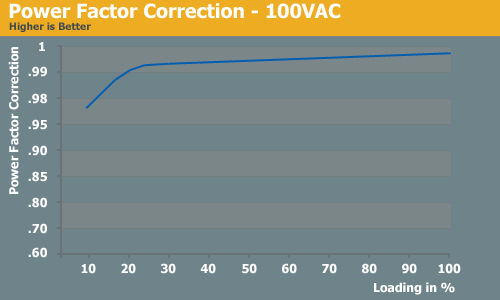
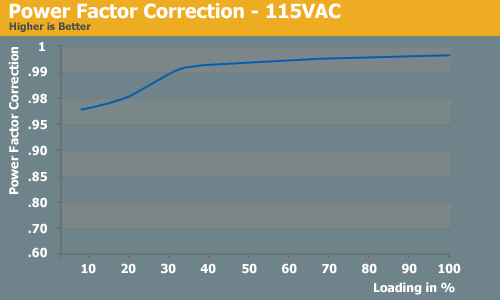
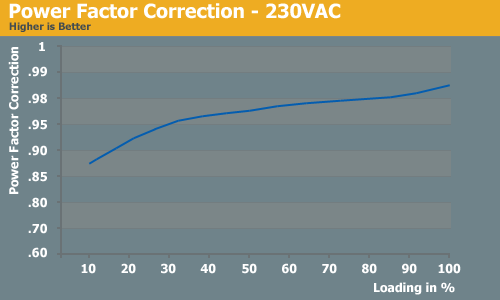
Temperatures (Ambient constant 25°C)
With an ambient temperature of 25°C we have added a new test to our regimen. With the additional results we hope users will be better able to form an opinion about the performance of the test power supplies. Speaking of additions, we have also added a new graph which shows the two heatsinks and the exhaust temperature together. Hopefully, we are done with making any more additions, as adding any more graphs at this point will likely do more harm than good in terms of conveying information without overwhelming anyone.
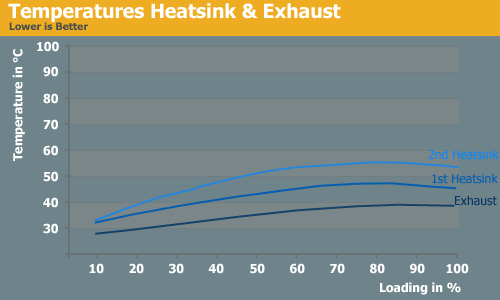
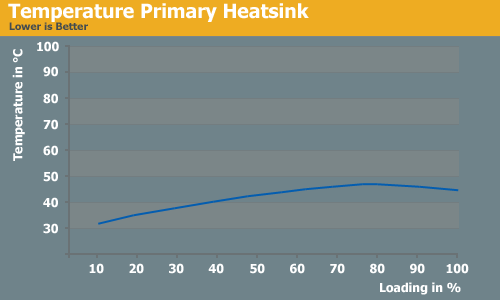
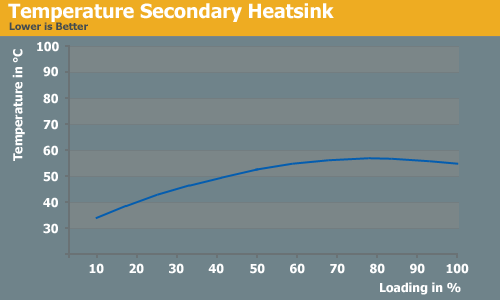
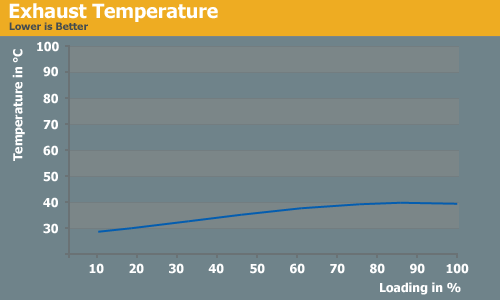
These results at 25°C are clearly lower than at higher temperatures. The second heatsink which is the hottest is just getting up to 56°C and decreases together with the other temperatures at 80% load. This is caused by the fan which runs at over 2400 RPM at that point. At the highest loads it is running at up to 3800 RPM and therefore the curves all start decreasing. More fresh air is coming through the power supply and therefore the components are better cooled.
Unlike the OP650 from Silverstone we see that the two heatsinks in the Silencer have a similar temperature. At most they have just 10°C difference, which is most likely the result of the two heatsinks being in relatively close proximity to each other. Not only that but they also don't get as hot as in the OP650.
Temperatures (Ambient 25-50°C)
We feel it is important to show what each power supply is truly capable of providing. The easiest way to separate the cream of the crop from inferior quality is to let the power supplies run in a very hot environment. Cheap components give up quickly and under stress conditions we can force lesser power supplies to fail. Good components will withstand the tremendous heat and keep on running. With increasing heat we will see the voltage of each rail dropping. This is a normal response from the components since they cannot deliver the same performance with increasing temperatures.
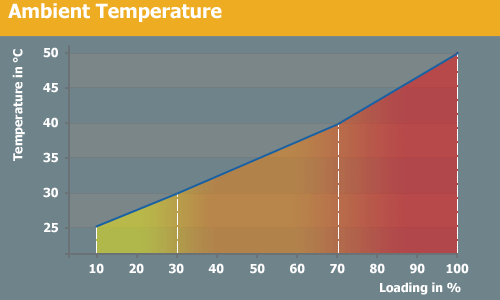
To heat up a box to 50°C you don't necessarily need a thermal chamber. For our tests we are using a natural circumstance. Our acoustic testing box is well isolated and will heat up with the running power supply inside. While this will not give us accuracy to a tenth of a degree, we can get a very good result for our use. To help the chamber heat up, we installed high wattage light-bulbs. If the temperature gets too high we cool it down with fresh air from outside. In this way we keep the same temperature for the different loads on each unit.
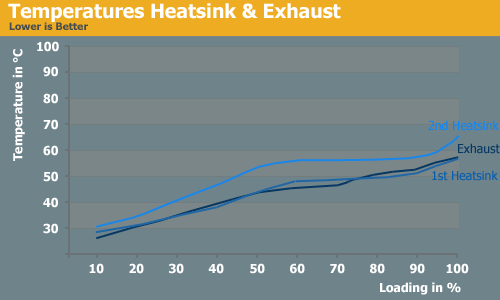
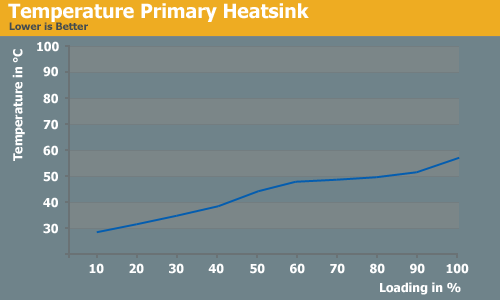
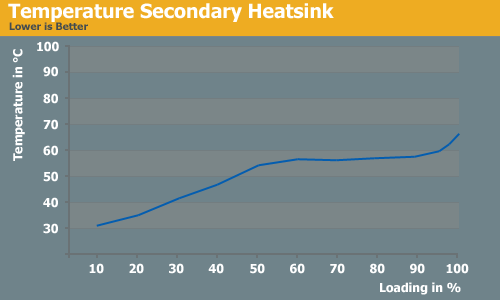
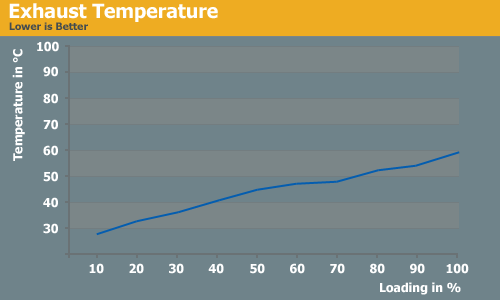
Under higher ambient temperature the heatsinks show similarities to room temperature. They get progressively warmer but the results are almost parallel to each other. The exhausted temperature is generally close to that of the primary heatsink. In comparison with the OP650 the secondary heatsink of the Silencer is much bigger in size. With the bigger size it has an increased capacity and better ability to transfer the heat into the air. The heatsink becomes cooler and can therefore cool components attached to it better.
Acoustics and Fan speed (Ambient constant 25°C)
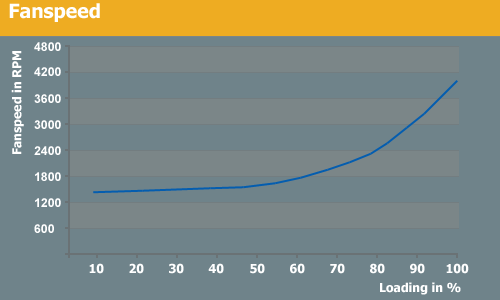
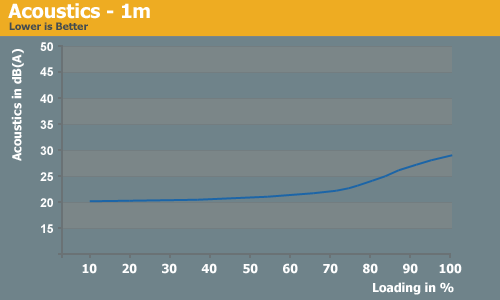
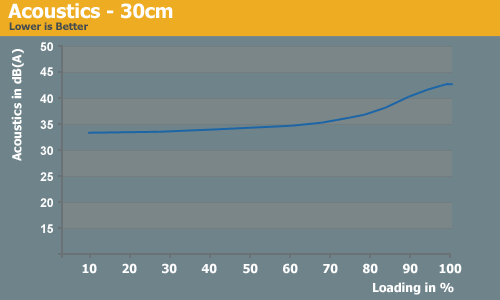
At a normal room temperature this power supply almost earns the right to call itself Silencer. During most of the testing it was running quiet and not noticeable over typical room noise. With increasing load the fan begins turning faster but it still remains quiet. Even at a fan speed of around 2000 RPM it was still under 30dB(A) from 1m distance.
Since we had already tested under high temperature conditions we knew how loud the fan could get, so we were pretty impressed at how quiet the PSU could be at lower room temperatures. With full load on the power supply and increasing heatsink temperatures the fan speed increases and reaches up to 3700 RPM. At this point it is clearly noisy and nothing close to being a "Silencer" anymore, but it's still much quieter than at 50°C ambient temperature.
Acoustics and Fan speed (Ambient 25-50°C)
At a higher ambient temperature our noise results are quite different. The fan runs at much higher speeds overall and thus generates more noise. In our opinion, the results are not visible enough on our graphs. This might be visible by adding a Sone test which attempts to measure the actual loudness heard by the human ear. Sone cannot be tested with a normal setup but we are looking into getting the proper equipment for future testing.

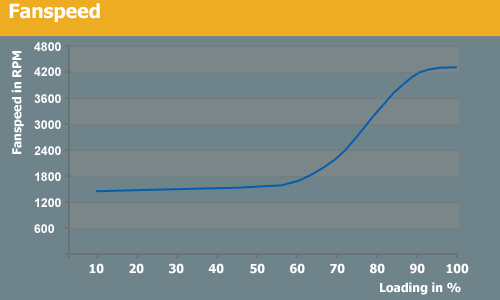
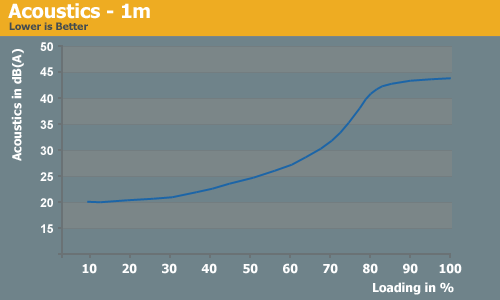
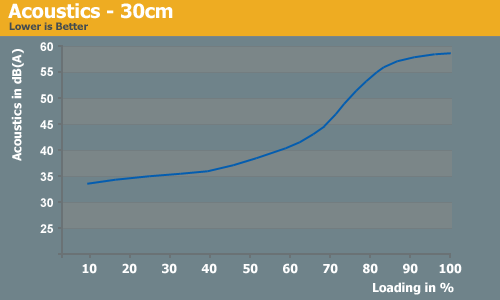
Up to a medium load the fan rotates at an average speed but it's still much noisier than at room temperature. From 60% on fan speed is clearly increased and the 750 Quad became the loudest PSU we have heard so far. It tops out at a maximum 4200 RPM, at which point we would compare the noise levels to that of a hairdryer. The result is a very high SPL of 45 dB(A) from 1m, which can also result in a very annoyed user sitting in front of the PC. Silencer? Certainly not at these temperatures and loads, but then creating a PC that approaches silence while drawing over 700W of power is more than just a little difficult.
Final thoughts
In total the PCP&C Silencer 750 Quad had an impressive showing in our tests. What we have seen until now still has surprised us. PCP&C has been around a long time, but until now they never made it over the big lake to Europe. They will clearly have a big advantage now with OCZ and their well established sales channels.
The build quality is very good except for the flaking paint-job. That can be avoided by getting the non-CrossFire version, but the red color is very eye-catching and may be one more reason for some users to choose this PSU.
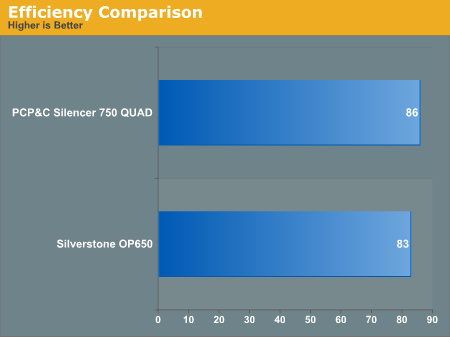
Since this is our second review we only have one power supply to compare with, but the Silverstone OP650 already had a very good efficiency level which has been topped by the Silencer 750 Quad. With more reviews to come we will have to wait and see how this table evolves in the future, but the PCP&C efficiency result is definitely going to be hard to beat. The standby efficiency has been good as well and it used only 0.8W without any load. With increasing load on the 5Vsb rail it showed us excellent results from up to 85% efficiency.
From the performance side the results were also excellent. The 3.3V and 12V rails are stable under any temperature and only the 5V rail has any minor flaws. Even these flaws aren't show stoppers, as the results are all well within the specifications. The 750 Quad is able to deliver its specified output, though with the voltage dropping we had slightly less than 750W. Since all voltages remain within spec and the PSU isn't bursting at the seams, there's clearly room for more.
In the area of naming, the Silencer falls a bit short when we look at the real measured noise levels. It is not a noisy power supply as long as the load remains under about 80% and ambient temperatures are below 30°C. The same holds true for most other power supplies, but then most of those don't put "Silence" in their name. To compare this unit with units that use 12cm fans we definitely see some shortcomings, as in our subjective opinion as well as in test results most power supplies with 12cm fans generate much less noise than the Silencer.
The idea of using a big gap between the fan and the heatsinks in order to reduce turbulence sounds very good initially, but if you look at the acoustic results it doesn't appear all that great. We would even go further and say that the gap doesn't bring much of a difference at all since you hear the fan noise, just like in every other power supply. So what does this small gap bring with it? First the housing needs to be extended, which means that the price for the case increases, the power supply is a bit heavier, and you pay for slightly higher transport costs. For the end-user it might not be a significant difference but if you calculate prices in terms of mass-production it may not be such a great idea. There's also a concern that the extra length may make the PSU less suitable for use in some cases, so users will definitely want to make sure that their intended case can accommodate a large power supply.
High connectivity is given through the various cables that offer differing lengths. Many other manufacturers also do this and it pays off. The user has more flexibility in working with cables and connectors and there are enough connectors that we would be hard pressed to imagine a scenario where an adapter or splitter would be necessary. This is also the first time we have seen a 14AWG power cord delivered with a power supply, which is just one more indication of PCP&C commitment to quality. With increasing power the cables need to be thicker, so now we just have to see how much the power outlet can provide.
With the results we have seen in this review PCP&C lives up to every advertised feature, and even the noise levels turned out to be real - with the above qualifications. The Silencer 750 Quad isn't like most other companies that advertise an incredible 17dB(A) only to deliver 27dB(A) at best. Given the overall quality and performance, the price of around $199 USD in the States and 150 EUR in Europe make this power supply a fair deal, especially for those looking at running a high-end system with multiple graphics cards.
Update: We've got word from OCZ that we've tested one of the first samples of this power supply and thus the paint job was done by covering the normal black paint. The paint job of the final version which is available in the shops will not flake off like our model.







